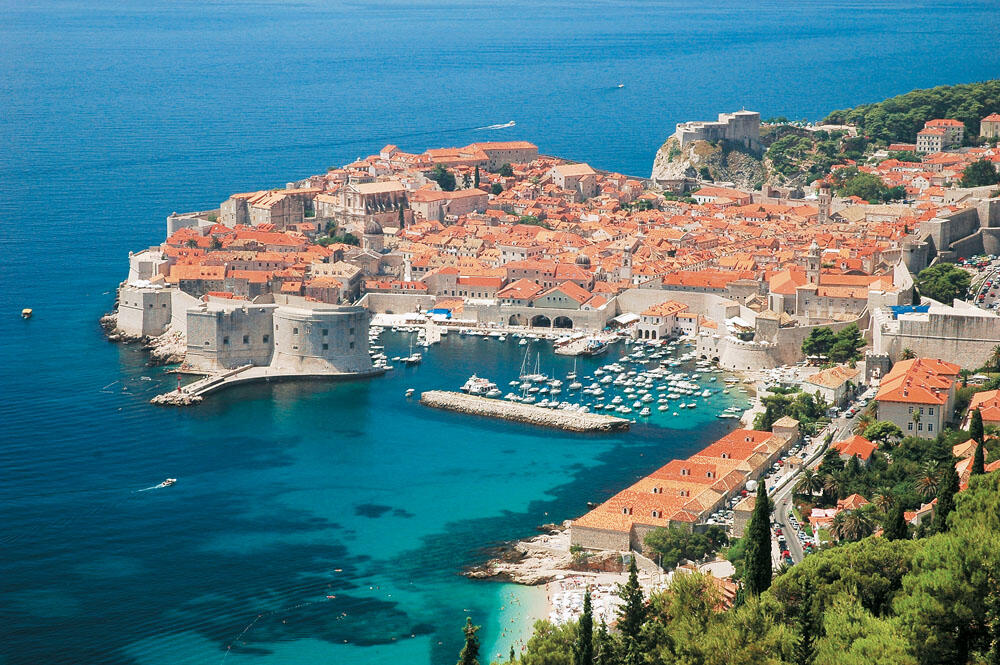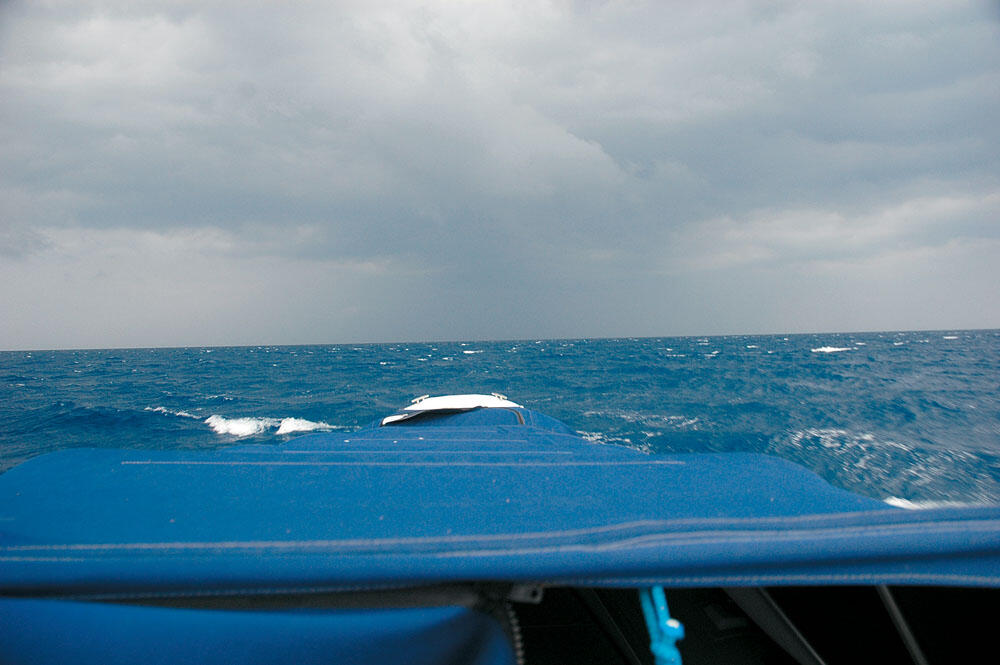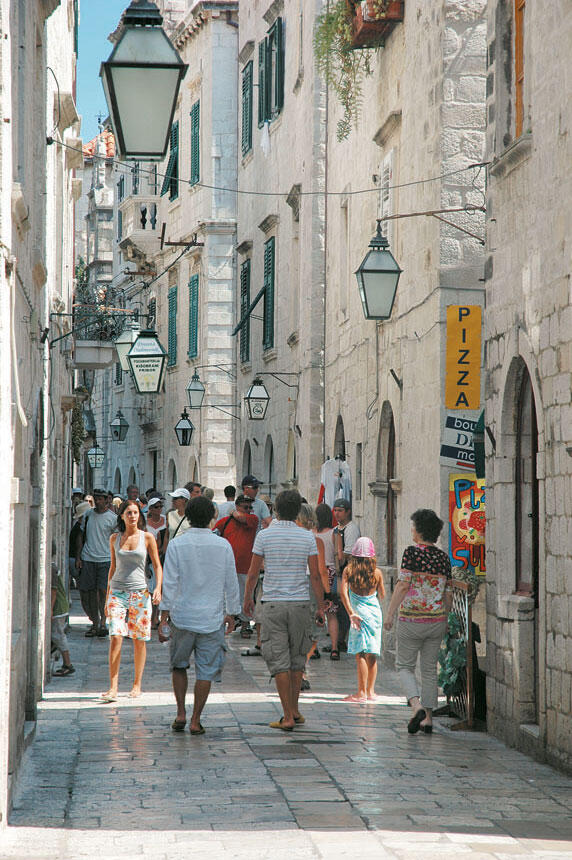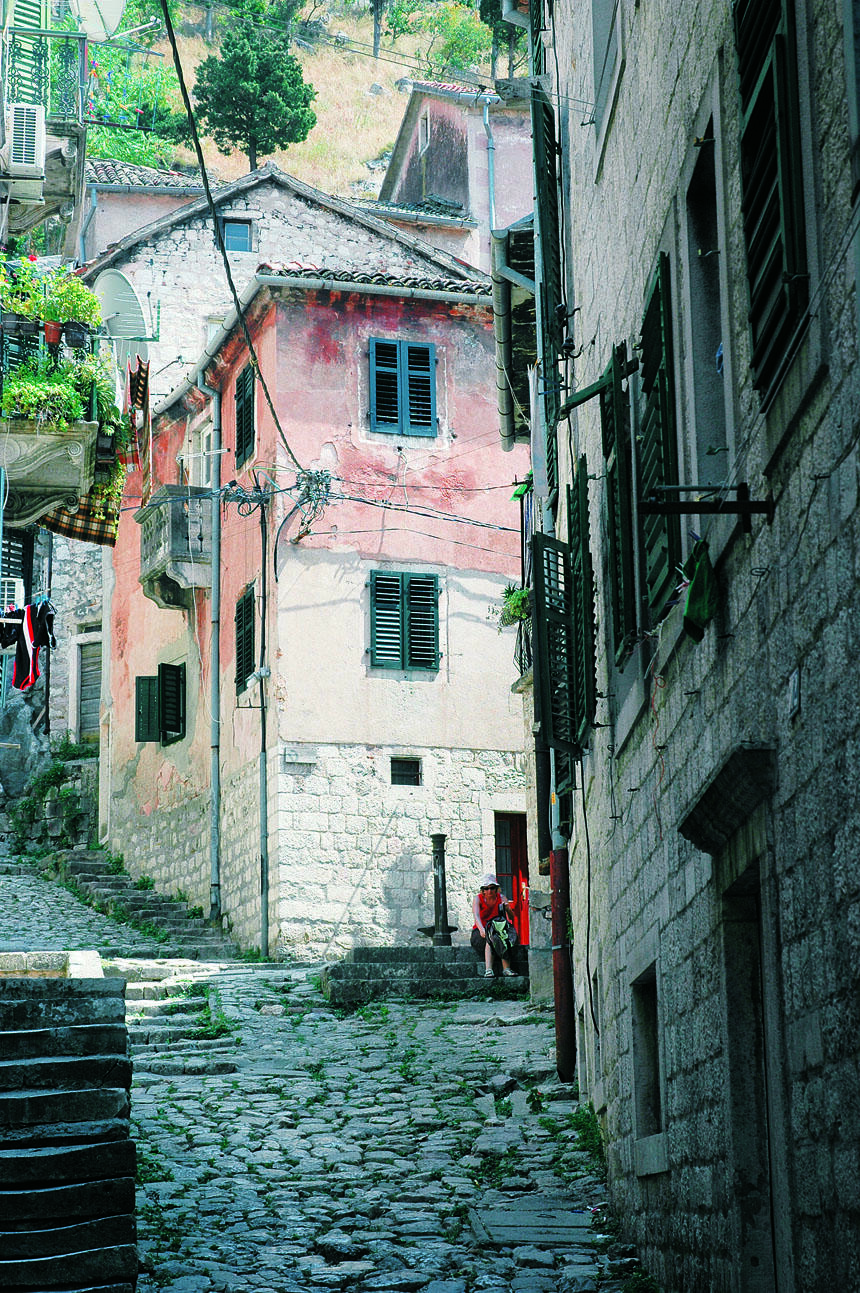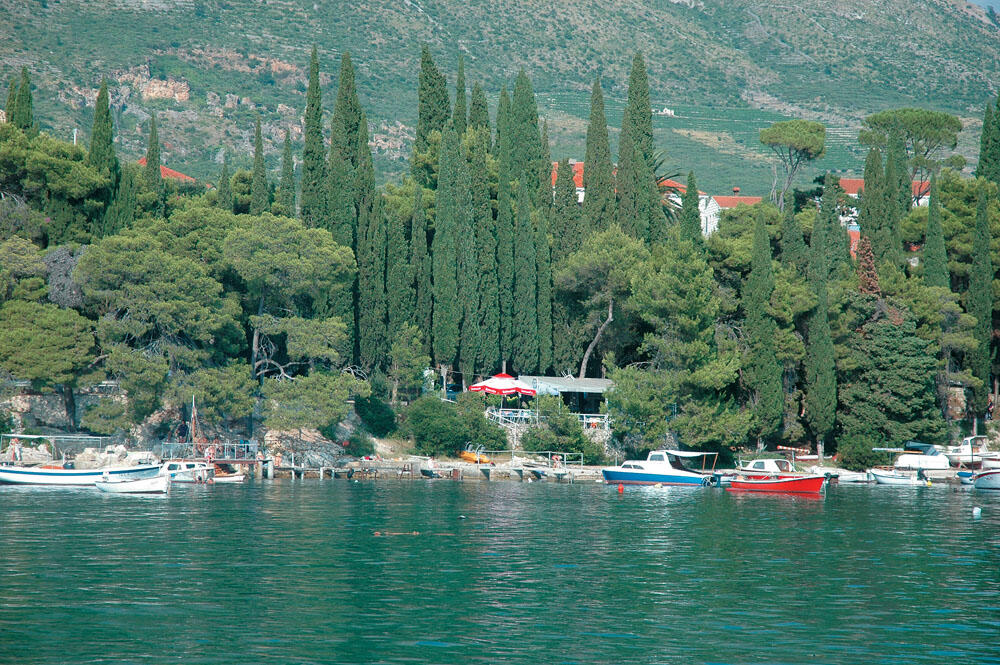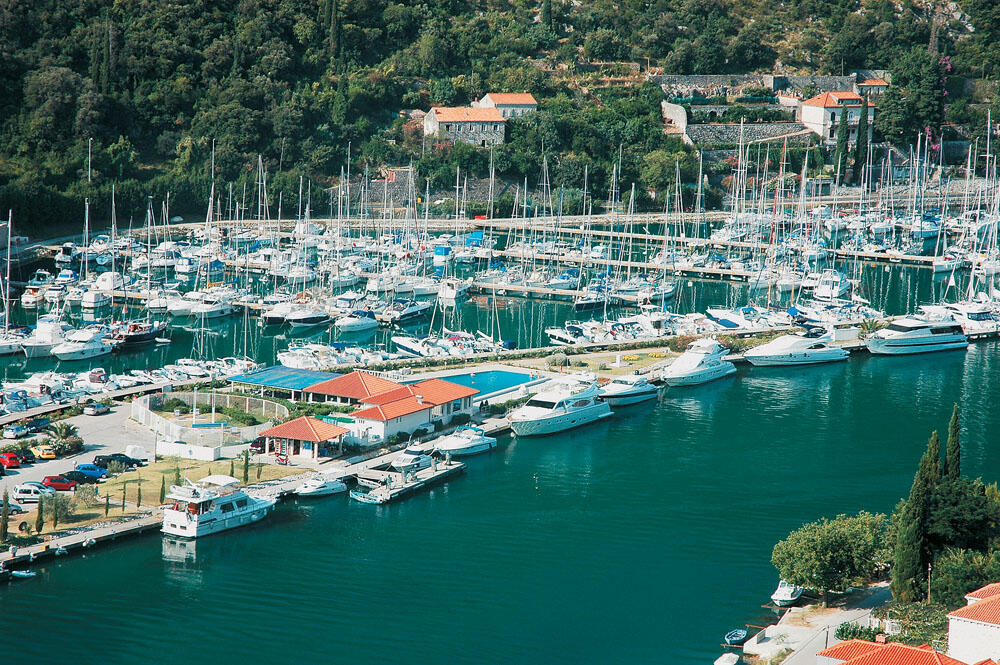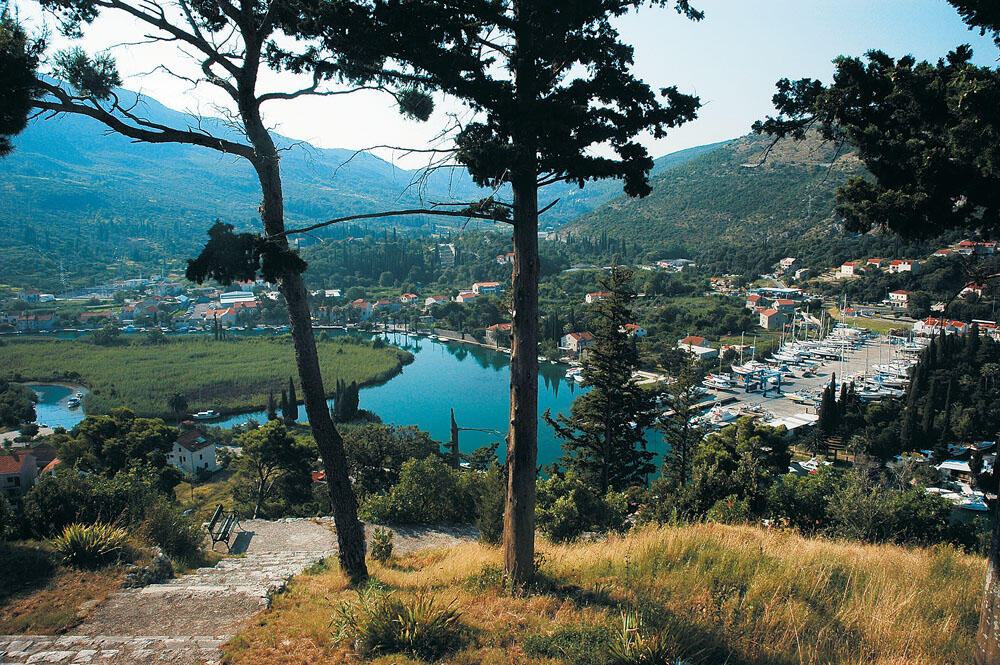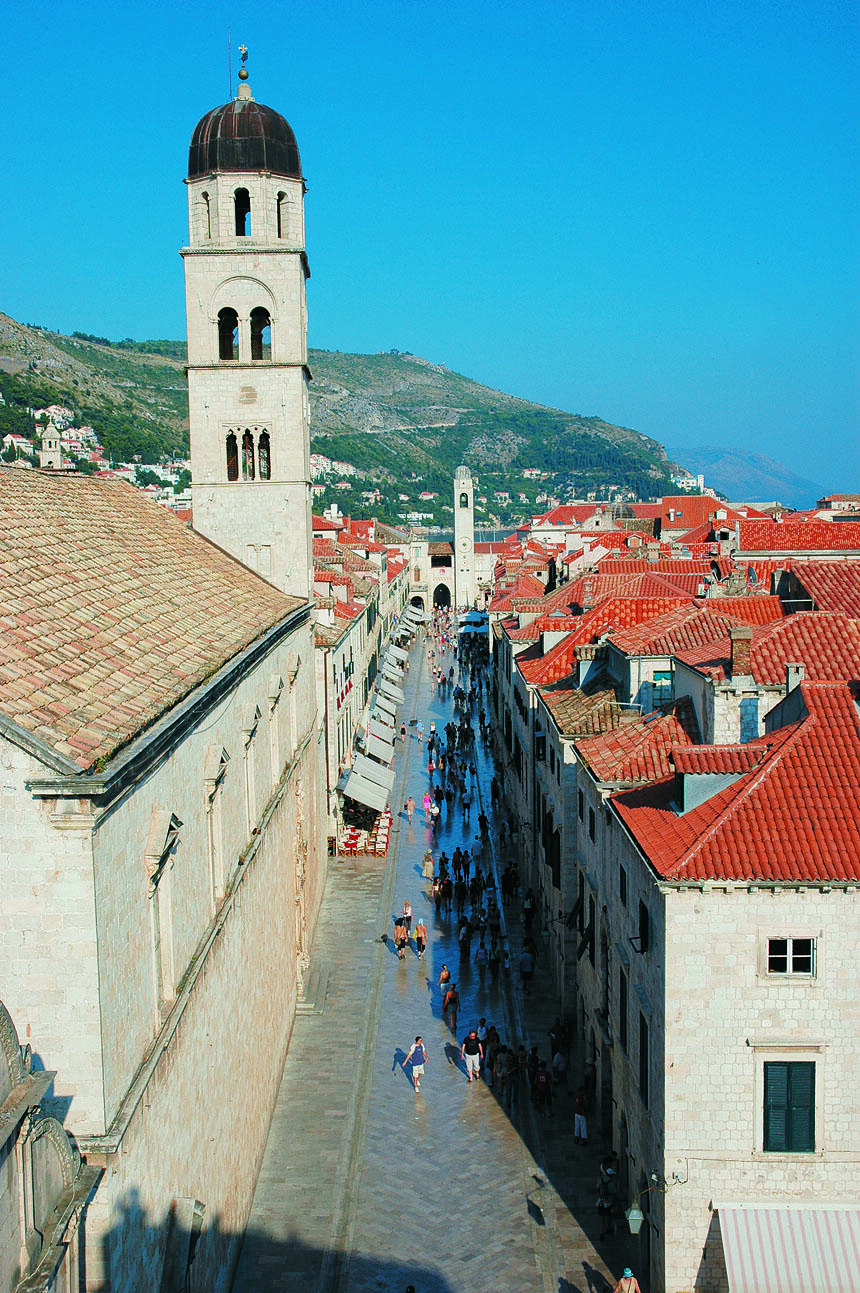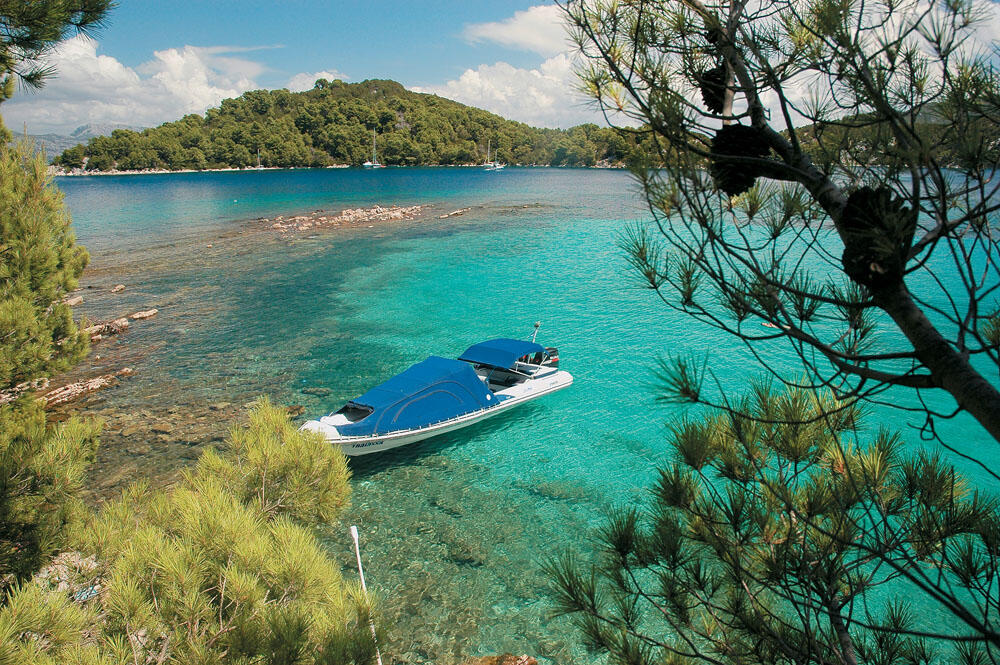
At the islands of southern Dalmatia (2nd part)
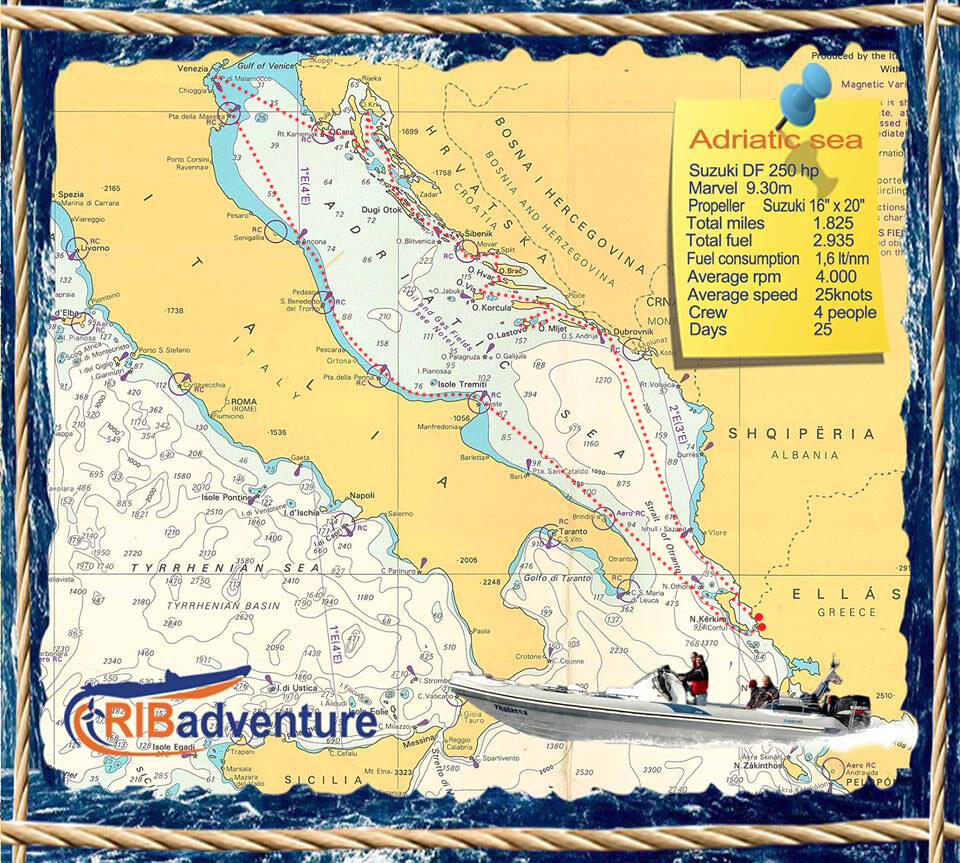
Trip in Dalmatian Coast

At the islands of southern Dalmatia (2nd part)

Trip in Dalmatian Coast

Exploring the Dalmatian coast
After all, is it our passion for "travel" that drives us or our thirst for new wanderings in new fairytale destinations? Be that as it may, a new route chart on the nautical chart, the anticipation of a new place that is faintly visible on the horizon and the challenge of the unknown that gives rise to unprecedented emotions, are the "cherries" on our journey...
We couldn't sleep that night. We were thinking of nothing but the journey. As if it was our first time. Everything had been erased from our minds and already our thoughts were traveling across the vast blue. Before dawn, with the fortified coffees in his jeep, we towed the heavily laden inflatable. We had many kilometers to cover to Sivota where we wanted to arrive in the early afternoon so that we would have some time to drop and organize the boat, which would accommodate four people for a whole month. With endless discussions and analysis around the trip, which from the phase of preparation and planning would finally move to the phase of its implementation, the kilometers quickly rolled by. Of course, the new sections of Egnatia Street that were opened to traffic also helped in this, and so at five o'clock in the afternoon we entered Sivota. We quickly headed to the nearby gas station where we filled up with 440 liters of fuel, while also stocking up on ice, water and food. With great difficulty we dropped the inflatable from the slide located inside Sivota and then the "marathon" began for a place in the new marina which unfortunately is completely disorganized. After an hour and after fighting with some fishermen who have the impression that the sea is their property, we finally moored on a tourist boat. The time had passed, and, hastily lest the night should overtake us, we arranged our things in the tambours, so that we might be ready for the long journey.
Sivota - Dubrovnik: 220 n.m.
Time 06:15 and we leave the marina behind. The weather, no more than 3 Beaufort was coming from the southwest. With a speed of 26 knots and the engine working smoothly at 4000 rpm we entered the Corfu channel. Some clouds over the mountains of the island worried us a bit, but luckily they dissipated quickly. In about an hour we passed the narrowest point of the channel, from where we set our bow for Cape Gjuhezes which is the westernmost point of Albania.
At a constant speed, which for many reasons we must maintain on long journeys, at 09:15 we had already traveled 74 n.m. and our bearing was N40°14' E19°11'. From this point, we charted our final course for Dubrovnik. The compass read 341 degrees, the weather was still south-westerly at 4 Beaufort, but it was trying to make a five. Our sailing was pleasant, with a reduced speed now reaching 22 knots at 3800 rpm.
At 11:30 our bearing was N40°58' E18°53' and our course was fixed at 341 degrees.
We had traveled 120 nm. more, i.e. than half of the total distance, and everything showed that we would arrive at our destination at the scheduled time.
We had been traveling for some time now in a cloudy and gray atmosphere, but we had the weather astern and were not particularly worried. But you never know at sea...
It was 12:10 when at some point I started to notice the waves, which probably had lost their periodicity and were slowly becoming turbulent.
This fact began to trouble me, but by looking up, all my questions were resolved. The sky in the background, directly over our path, was pitch black. I continued to keep the course and speed of the boat steady, while the waves now coming offshore began to be clearly seen. "We are slowly entering the storm" I muttered, while suddenly in the background the first lightnings were seen menacingly tearing the black sky. And we still had a full 82 nautical miles to go. I already began to organize in my mind the alternative routes that had been meticulously analyzed during the planning of the trip. At the same time, the weather was getting heavier and heavier, while the foam of the waves seemed to glow in the leaden sea. A sight very very beautiful but extremely inhospitable. I insisted on holding my course as the inflatable responded magnificently to its head-on collision with the waves. I intended to continue through the storm as long as our strength permitted, hoping it would not last long. We rowed for some time, but the waves got so rough they made 22 knots feel like 40, and the wind was now making its presence felt. After a while it became so strong that the distance between the waves began to decrease, while their crests became more and more vertical. My will to continue was suddenly cut short when I realized that we were entering a very strong 6 with an obvious upward trend and we still had many miles to go. The waves were merciless and the sea bathed the inflatable alive. "That's it," I exclaimed, and turned sharply in time, matching my speed to that of the waves, so as to buy some time to decide which course would be best to take, considering the conditions and fuel, with a view to safety and our more comfortable sailing, without at the same time deviating too much from our course. Of course, the "length of day" factor did not concern me because we had many hours until it got dark.
Nautical information
- Sivota: The town has had a marina for three years, but, as is almost the norm in our country, it remains unfinished. Without water and electricity, while the planned slide was never built and everyone is looking for those responsible, throwing the blame on each other. But beyond all that, everyone in the marina operates arbitrarily. The fishermen have caught a large part of it, permanently leaving their pryamatas on the dock and not allowing anyone to tie up even for a while. Some "smart" people moor their sailboats, taking up the entire marina and ignoring everyone else. So while the marina is virtually empty of boats, there's hardly any free space, so you're begging someone to moor up on it to make the night. Is it so hard to have someone in charge to at least sort out the boats and prohibit mooring? The marinas in our country are few, but it is a shame that the few that still exist are abandoned. And we are fine, but is it possible for a foreigner who will come with his family and his boat to Sivota to set foot there again since he is not provided with even the basics? Not to mention the sloppiness of the local professionals. Two bags of ice, at the amazing price of 10 euros. Do you want to hear the excuse? The gentlemen work three months a year and the other nine they want to live at our expense. It is therefore not at all surprising that whole fleets of sailboats and yachts go up and down the coast of Croatia every day, where there is all the infrastructure for maritime tourism, while here we "sleep the sleep of justice". Let's not complain about our tourism, which is still holding up well, certainly in relation to what we provide. Let's face the incredible beauties of our country, otherwise I don't think we would see a foreign flag on a boat...
Of course, the dirt slide that was convenient for us for so many years disappeared, with the rationale that the new one would be built in the marina. Now there is only the slip that is inside Sivota, but to get there, especially if you have a boat over 6 meters, things become very difficult because you have to pass through the busy shops and double-parked cars, while there is no space for maneuvers.
We therefore recommend for launching the boat the Drepano area in Igoumenitsa, which is located next to the entrance of the wider bay that hosts the port. There we have all the comfort to launch and prepare the boat, since the slip is in a non-residential area. But we have to find a way to insure car and trailer. Now let's cross over to the other side... - Throughout Croatia, there are 45 marinas operating with 15,000 berths. Of these, 21 belong to the ACI club (Adriatic Croatia International), founded in 1983 (when we, a predominantly maritime country, did not know what a marina was). This is a chain of marinas scattered all over the place, from Dubrovnik in the south to Umag in the north, and they provide a high standard of service. Shops, restaurants, cafes, laundries, swimming pools, tennis courts, fuel, ice machines, grocery stores, internet cafe, boat technical support and, of course, maximum security for stay and overnight stay. In other words, they have everything for nautical tourism, with a special emphasis on family holidays.
Imagine these infrastructures existed in Greece. It would certainly become inseparable in our seas. And the authorities are still looking for ways to increase our tourism for so many years... - Dubrovnik has a large port in Gruz which is 2 km from the old town. Line ships and large yachts dock here, and there is also a marina for local boats. 6 km from the old town, at the mouth of the Ombla river in the Komolac area, is the Miho Pracat Aci Marina with 450 berths and another 250 on land. All pitches have electricity and water, while the marina has everything: cafes, restaurants, tennis court, swimming pool, bathrooms, washing machines, grocery stores, marine stores and of course fuel. The price depends on the dimensions of the boat. We gave 30 euros a day.
Informations:
Aci Marina - Dubrovnik - Στίγμα Ν42°40' Ε18°07' Τηλ. 020-455-020, Fax 020-455-022
Changing course
At the point where we were, we had two options:
To head towards the port of Bar, in Montenegro, on a course of 16 degrees, from where we were separated by 50 nm. or to completely change course towards Durrës, Albania, on a course of 88 degrees, but at a distance of only 33 nm.
I preferred the first one, because we were only slightly off course and in time to reach Dubrovnik which was our destination. So I turned the inflatable on a course of 16 degrees and was trying to get a decent speed.
We had the weather on our left mask, but the bumps were still bad. I persevered for a mile or so, but the sea grew worse, and was by no means navigable. The awnings were getting watery, our eyes itched from the salt, while I struggled in vain to find a flat float. Without a second thought, I set sail for Durrës, simultaneously abandoning all hope of approaching Dubrovnik. I got on a course of 88 degrees and with the weather on the side I was able to maintain an average speed of 18 knots.
Our sailing was now decidedly improved, but the wetting we were eating was unprecedented. Even though we were dressed like lobsters in the wetsuits, the water managed to seep through them, until the soaked clothes inside became very embarrassing. We stopped for a few minutes, put on dry clothes, put on the wet wetsuits again and continued. We gritted our teeth and in two and a half hours we were a few meters from the coast of Albania. The weather here was much better and we quickly got something ready to eat, followed by an invigorating coffee under the machine-gun-strewn cliffs of Albania. After getting back on our feet a bit, we unanimously decided to continue upwards leaving the Albania holiday for another time. The sun that began to make its timid appearance warmed us pleasantly and so at 17:40 we passed near the mouth of the river that separates Albania from Montenegro. The landscape started to get more beautiful and we still had 35 nm left. for the Bar where our little Odyssey would finally come to an end. We covered them quickly in an hour and a half and at 19:10 we tied up in the marina. In short, we started for Dubrovnik and Croatia, we met in Albania and Bar in Montenegro. We had booked a full 13 hours at sea, but we found the mood to go out for a walk in the city.
It is the well-known "anesthesia" that catches you after a long-hour sailing and you reach a point where you don't feel tired or anything. It took us quite some time to complete the procedures for entering the country and we were now relaxed enjoying our drink at a beach bar.
There were very few times during my travels that I had to change my planned course. But always, when planning a trip, I paid special attention to alternative routes and ports to be prepared in a difficult moment.
It is necessary for our safety to spend many hours over the map and to know everything around our course, regardless of whether some areas are of interest to us or are not even part of our holiday plan. As easily as we chart our course on the nautical chart, it is often so difficult to follow it at sea. We should never forget this, regardless of whether we are on a short or long journey.
Just as we must not forget to have our tanks full, even when we are going to travel short distances.
Imagine how much trouble we would have had on this particular trip if, at the time the weather conditions prevented us from continuing, I knew nothing of the areas around my marked course.
In the panic of the raging weather, instead of being focused on our sailing, at that time we are anxiously looking for maps and ports. It is certain that we would not be able, nor would we have the clear mind to make the right choice.
Bar
Bar is one of the main commercial ports of Montenegro with about 14,000 inhabitants. It is certainly not one of the attractive places that we would set as a tourist destination, but it is a worthy port, a strategic resting point on our long journey to the Dalmatian coast, where we can spend the night in absolute safety. On the north side of the harbor there is a small marina with all the essentials: a small cafe, a shop with marine supplies (very well equipped), public toilets and of course a petrol station on the dock. Right next to the marina there is a large square where the beach road starts, which hosts a lot of people in the afternoons. We were particularly impressed by the locals who are very simple, cordial, welcoming and mostly smiling.
Kotor
We woke up in a very good mood and after enjoying our morning coffee, we fixed the inflatable and reviewed our schedule. Dubrovnik went back a day, but "every obstacle is good", as they say, because now we had the opportunity to visit the famous Kotor which we had left out of our plans because we didn't have enough days. With our forced change of course though, Kotor was only 30 miles ahead of us and we weren't going to let the opportunity go to waste.
So, without hurrying, at low speed we sailed past the beautiful coasts that in two hours led us to the mouth of the very large Kotor fjord which stretches for 17 nautical miles. It is one of the best natural harbors, once known as the largest southernmost fjord in Europe. Within it three large basins are formed surrounded by high mountains and connected to each other by narrow canals. The widest point reaches 7 km, the narrowest 0.3 km, while the maximum depth does not exceed 60 meters. Sailing towards the third basin we passed close by the magnificent city of Perast with its imposing old buildings which, although mostly in ruins, strongly emphasized the glamor of other times. We were slowly approaching the homonymous city of Kotor, which revealed its greatness to us only when we reached a distance of a few meters.
The impressive walls that surround the old medieval town run for four kilometers and literally climb vertically up the high hill behind, reaching the San Giovanni fortress from where the view is amazing!
We stopped in front of the main gate of the wall that leads to the heart of the city, which is one of the most well-preserved medieval cities in the entire Adriatic. Stone-built buildings, beautiful squares, from where start cobbled narrow streets full of cafes, taverns, bars and shops of all kinds. It is no coincidence that every year more and more tourists visit the old city, which is even under the protection of Unesco. It didn't take us long to get to know the small town and after our beautiful walk we enjoyed our coffee in the medieval environment, where a lot of people gather creating a unique atmosphere.
From here on we had wonderful places to see and full of similar feelings we lifted anchor for Dalmatian coasts. Leaving the bay of Kotor we were already in another country, since its northern bay belongs to Croatia.
SOUTH DALMATIA
It stretches for 75 nm, from the border with Montenegro to Ploce. If we wanted to "label" this area, we would say that it is from S 42°20' to 43° and from E 16°25' to 18°30'. Southern Dalmatia includes Cavtat, Dubrovnik, the entire Peljesac peninsula, as well as the islands of Elafiti, Mljet, Lastovo, Korcula.
Southern Dalmatia is home to two of the most famous places in all of Europe, Dubrovnik, known as the "pearl of the Adriatic", and the old town of Korcula, which is surrounded on three sides by the sea and is an enviable destination. Of course, the rest of the places that certainly deserve our attention do not go unnoticed...
Cavtat
In less than an hour we covered the 19 miles that separated us from Cavtat, the southernmost tourist resort of the Dalmatian coast. Cavtat or the ancient "Epidavros" is a beautiful little town with wonderful palaces and historical monuments, country houses and hotels along the coast, which are among the most beautiful in Croatia. It is built on the ruins of the ancient Greek colony "Epidauros" which was destroyed by Arab and Slavic raids in the 7th century AD.
But what makes it stand out is the dense but special vegetation, where tall cypress trees emerge from among pines which have an incredibly bright green color.
You can moor at the small port located on the western side of the bay and enjoy a walk on the beautiful paths in the forest, next to the green sea, in an environment of incredible tranquility and oblivion. There are many shops, cafes and restaurants under palm trees, where you can try traditional Dalmatian cuisine. We were impressed that, despite the many tourists it attracts, it is a very quiet city that rests the visitor.
Dubrovnik
One of the most beautiful cities of the Mediterranean welcomes us at the southern end of the Dalmatian coast. We are just a few meters from the famous walls, in front of the old port. One of the most beautiful images the human eye can encounter! I had seen many pictures and read many flattering comments about Dubrovnik.
But I was also a bit wary because usually when you expect a lot from a place you are disappointed when you face it, not because it is not nice, but simply because you have made it a fairytale in your imagination and you expect to see something shocking. And yet, it was one of the few times that reality far exceeded even the most beautiful image we imagined. The sight was incredible. No words and no description can convey what our eyes saw. Our excitement is indescribable. We were speechless, absorbing with all our senses the magic that this place radiates. For a long time we admired the majesty of the walls that rose before us. At some point we woke up and sailing close to the shore, we headed to the port for the paperwork and to declare our arrival, eager to spill out into the alleys of 'Dubrovnik'. In a short time we were tied up at the ACI marina and despite our tiredness we took the bus that in a few minutes took us to the old town.
The medieval city of Dubrovnik is the main attraction of the entire Croatian coast and not without reason. Even George Bernard Shaw was so impressed during his stay there, in 1929, that he emphasized: "if you want to see heaven on earth, come to Dubrovnik", which means that... "if you want to see heaven on earth, come to Dubrovnik". You see, even from that time, Dubrovnik was a well-known tourist resort.
Also known as "the pearl of Adriatic", it has been declared a world cultural heritage city by Unesco. Although 70% of the buildings were destroyed by the merciless bombings of 1991, the city quickly healed its wounds. Nine historical buildings were completely damaged by the fires of the war, but they were repaired in record time and in such a way that nothing bears witness to their reconstruction.
For many years it was known as Ragusa, before being renamed Dubrovnik, from the Serbian word Dubrova, meaning "little forest".
With a population of 50,000, it is located at the foot of the 412-meter-high Srd mountain, in a valley closed to the southwest by the Lapad plateau, while the old town is built on a small reef. After the construction of the large harbor at Gruz Bay, the city expanded there and has begun to spread towards the Lapad Peninsula, low on the slopes of Srd, and towards Zupa.
We enjoyed a hot espresso in one of the cafes in the Placa, observing the multitude of tourists of all nationalities, enchanted by the beauty of the place, enjoying their walk through the numerous cobbled streets. After walking around for some time, we made our way to the impressive defensive walls with the unique towers that surround the old city and protected it for centuries from the conquerors. The entrance is to the left of the Pile gate. They extend over a length of 2 km with a height of over 25 meters. The first part of the walls was built in the 13th century, while in the middle of the 14th and 15th centuries, under the threat of the Turks, the 1.5 meter thick walls were reinforced with 15 square fortifications. The circular Minceta tower protected the northern end of the city from land, while the western end was protected from land and sea by Lovrjenac fort. The Pile gate was protected by the Bokar tower, while the eastern entrance where the old harbor is located, by the Revelin fort.
They are considered by many to be among the most beautiful walls in the world. A walk on the walls, which corresponds to an hour's walk, is a unique experience.
The view towards the deep blue sea, but also towards the red tiled roofs of the houses of the old town, will remain unforgettable.
The old town hosts the summer festival every year, which runs from July 10th to August 25th. It is the most important event of the city, held traditionally since 1950, but also one of the most famous festivals in the world. Concerts, shows and traditional music are played on open stages throughout the city, but also inside the magnificent halls of famous buildings and churches. Croatian and world-renowned plays are presented, Greek tragedies and plays by Shakespeare are staged, while big names from the international art scene very often participate. Festive atmosphere in a medieval setting. An unforgettable experience...
Dubrovnik: heaven on earth!
- It takes several days to get to know the old city. However, a short stroll down the Placa, which is the main marble-paved pedestrian street, and through the narrow streets leading to small squares, observing the stone buildings, palaces, museums, monasteries, fortresses and a host of historical monuments, is enough to to understand why Dubrovnik is so famous. Here, time seems to stand still. There are many attractions:
- The central gate, Pile gate, dates from 1537, at the entrance of which there is a drawbridge that was raised every afternoon sealing the castle state. A few meters further inside is a second gate built in 1460, from where the Placa begins where the heart of the city beats. The Placa connects the main gate, located in the west, with the Ploce gate in the east, where the old port is. With the wonderful stone buildings that surround it, it is the most beautiful part of the city which is also a meeting point. This pedestrian street is essentially the dividing line between the first settlement and its subsequent expansion. This first settlement was founded by the ancient Greeks, refugees from Cavtat when it was destroyed by the Slavs.
- At the beginning of the main pedestrian street we meet the Great Onofrio Fountain, one of the famous buildings of the city, built in 1438, where the water brought from a spring 12 km away was collected.
- The church of St Blaise, the patron saint of the city, which is the most loved by the locals. It was destroyed by fire and rebuilt in 1717 in a baroque style by the Venetian architect Gropelli, who designed the statue of the Saint at its entrance.
- The Franciscan monastery, where the third oldest pharmacy in Europe is located, while it is the oldest that is still in operation today.
- The Rectors Palace, one of the most beautiful buildings in the Gothic-Renaissance style built in the 15th century. Its sculptures are amazing, as are the elaborately carved capitals. Concerts are often held on the lavishly decorated stairs of the palace during the summer festival. This palace, which housed the city's governor, is now a museum, with coins and wonderful works of art that testify to the city's rich history.
- At the eastern end of the city we find the Luza Square which was an old market and the imposing column of Orlando which is a well-known meeting point.
And that's not all: The archaeological museum, the aquarium, the maritime museum, the churches and monasteries that turn Dubrovnik into a world cultural center. It once flourished so much in letters and the arts that some called the city the "Athens of South Slavs."
...keep Ribbing!

